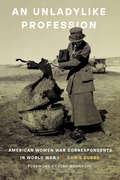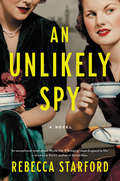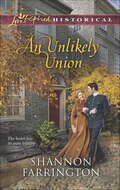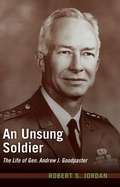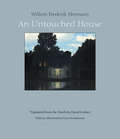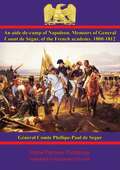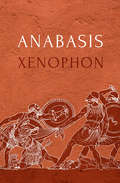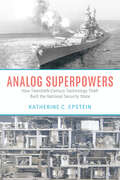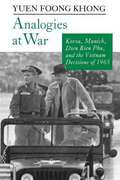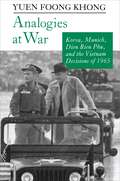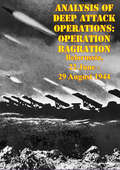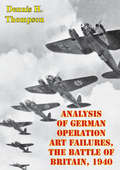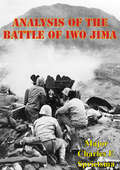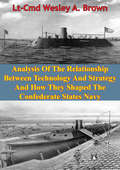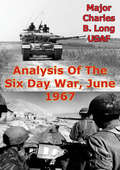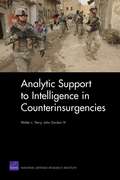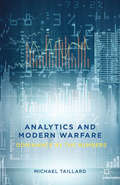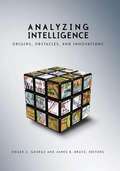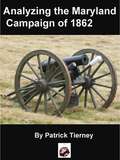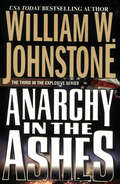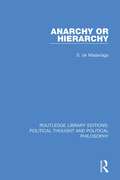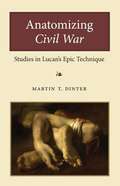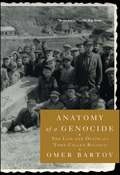- Table View
- List View
An Unladylike Profession: American Women War Correspondents in World War I
by Chris DubbsWhen World War I began, war reporting was a thoroughly masculine bastion of journalism. But that did not stop dozens of women reporters from stepping into the breach, defying gender norms and official restrictions to establish roles for themselves—and to write new kinds of narratives about women and war. Chris Dubbs tells the fascinating stories of Edith Wharton, Nellie Bly, and more than thirty other American women who worked as war reporters. As Dubbs shows, stories by these journalists brought in women from the periphery of war and made them active participants—fully engaged and equally heroic, if bearing different burdens and making different sacrifices. Women journalists traveled from belligerent capitals to the front lines to report on the conflict. But their experiences also brought them into contact with social transformations, political unrest, labor conditions, campaigns for women&’s rights, and the rise of revolutionary socialism. An eye-opening look at women&’s war reporting, An Unladylike Profession is a portrait of a sisterhood from the guns of August to the corridors of Versailles. Purchase the audio edition.
An Unlikely Spy: A Novel
by Rebecca Starford“A beguiling tale of espionage." -- Pam Jenoff, author of The Orphans Tale and The Lost Girls of ParisA twisting, sophisticated World War II novel following a spy who goes undercover as a part of MI5—in chasing the secrets of others, how much will she lose of herself?Evelyn Varley has always been ambitious and clever. As a girl, she earned a scholarship to a prestigious academy well above her parents’ means, gaining her a best friend from one of England’s wealthiest families. In 1939, with an Oxford degree in hand and war looming, Evelyn finds herself recruited into an elite MI5 counterintelligence unit.A ruthless secret society seeks an alliance with Germany and, posing as a Nazi sympathizer, Evelyn must build a case to expose their treachery. But as she is drawn deeper into layers of duplicity—perhaps of her own making—some of those closest to her become embroiled in her investigation. With Evelyn’s loyalties placed under extraordinary pressure, she’ll face an impossible choice: save her country or the people who love her. Her decision echoes for years after the war, impacting everyone who thought they knew the real Evelyn Varley.Beguiling and dark, An Unlikely Spy is a fascinating story of deception and sacrifice, based on the history of real people within the British intelligence community.
An Unlikely Union
by Shannon FarringtonThe Doctor's Wounded Heart Union Army physician Evan Mackay runs his ward of the Baltimore military hospital with tremendous skill but no warmth. He will do his duty by the Confederate soldiers in his care, but sympathy and tenderness left him after the death of his brother, a Federal soldier. So why can't he stop himself from warming to his beautiful, compassionate, unapologetically Southern nurse? Two years of war have shown Emily Davis that the men on both sides of the war need all the comfort and care they can get. And that includes a stubborn, prickly Scottish doctor. As Evan opens his heart to Emily, she can only hope he'll let her fill it with forgiveness...and love..
An Unsung Soldier
by Robert S. JordanGen. Andrew J. Goodpaster was one of the leading soldier-scholars of his time. He was one of the key figures during the Cold War - one who stood among the dominant American military and political personalities of those times. Goodpaster served Gen. Dwight Eisenhower in establishing the international military component of NATO and then served as his Staff Secretary. He achieved the highest international military command assignment possible - as NATO's Supreme Allied Commander, Europe and restored the integrity of West Point during a major ethical crisis. Upon his final retirement and for over a quarter-century thereafter, he was actively involved both the formal and informal world of Washington policy-making, making his mark repeatedly as a respected participant.
An Untouched House
by David Colmer Cees Nooteboom Willem Frederik HermansA brooding meditation on violence by a classic post-war Dutch writer who has drawn comparisons to Joseph Heller and Kurt Vonnegut.A mesmerizing, dark meditation on the legacy of war. An interloper and opportunist makes a grand house his own in the chaos of a war-torn countryside, only to find himself involved with occupying forces and enraged locals.
An aide-de-camp of Napoleon. Memoirs of General Count de Ségur, of the French academy, 1800-1812
by Général Comte Phillipe-Paul de Ségur Comte Louis-Phillipe-Antoine-Charles de Ségur Mrs Harriette Anne Crookesley Patchett-MartinSeeing a regiment of Dragoons process through Paris in 1800, Philippe de Ségur decided to join the French cavalry at the ripe old age of 19, swiftly becoming part of Napoleon's headquarters staff. From then on, his career was to be unlike many of his contemporaries, for he was the son of a well-connected father and a protégé of Napoleon's confidante, Grand-Marshal Duroc. He saw service in all of the major Napoleonic campaigns, not just a courtier, distinguished in the crucible of the cavalry charge of Somosierra and also the battlefields of Hanau and Reims.For his service under Napoleon he was forced into retirement from the army and took to writing his memoirs and historical works. His scathing attack on Napoleon's conduct during the Russian campaign Histoire de Napoléon et de la grande armée pendant l'année 1812 provoked an uproar among Napoleonic loyalists and landed de Ségur in a duel. His further memoirs were published posthumously, a three volume account edited by his grandson, and this edited version was translated into English. Being at the hub of Napoleon's headquarters gave him the opportunity to see into most of the major events of the era and he recorded these with wit and an impressive eye for detail.These memoirs are a must for any enthusiast of the Napoleonic period.Author -- Général Comte Phillipe-Paul de Ségur, 1780-1873Editor - Comte Louis-Phillipe-Antoine-Charles de Ségur, b. 1838Translator - Mrs. Harriette Anne Crookesley Patchett-MartinText taken, whole and complete, from the edition published in New York, D. Appleton and company, 1895.Original Page Count - xxvi, 440 p.
Anabasis: Bdehn. Buch V-vii (Kiraz Historic Travels Archive Series)
by XenophonAn ancient Greek mercenary soldier&’s account of leading an army on a dangerous march from Babylon to the Black Sea. Hired by a Persian prince hoping to take the throne from his brother, Xenophon was one professional soldier in an army of many when disaster struck and their leaders were killed or captured, leaving them stranded. Along with two others chosen by their fellow soldiers, Xenophon would lead the army to safety on the &“March of the Ten Thousand.&” It was a harrowing journey, and they battled their way through harsh climates and hostile enemy territories—but eventually made it home. This memoir of the adventure, known for its clear language and directness, has become a classic for those interested in ancient Greek history and military culture.
Analog Superpowers: How Twentieth-Century Technology Theft Built the National Security State
by Katherine C. EpsteinA gripping history that spans law, international affairs, and top-secret technology to unmask the tension between intellectual property rights and national security. At the beginning of the twentieth century, two British inventors, Arthur Pollen and Harold Isherwood, became fascinated by a major military question: how to aim the big guns of battleships. These warships—of enormous geopolitical import before the advent of intercontinental missiles or drones—had to shoot in poor light and choppy seas at distant moving targets, conditions that impeded accurate gunfire. Seeing the need to account for a plethora of variables, Pollen and Isherwood built an integrated system for gathering data, calculating predictions, and transmitting the results to the gunners. At the heart of their invention was the most advanced analog computer of the day, a technological breakthrough that anticipated the famous Norden bombsight of World War II, the inertial guidance systems of nuclear missiles, and the networked “smart” systems that dominate combat today. Recognizing the value of Pollen and Isherwood’s invention, the British Royal Navy and the United States Navy pirated it, one after the other. When the inventors sued, both the British and US governments invoked secrecy, citing national security concerns. Drawing on a wealth of archival evidence, Analog Superpowers analyzes these and related legal battles over naval technology, exploring how national defense tested the two countries’ commitment to individual rights and the free market. Katherine C. Epstein deftly sets out Pollen’s and Isherwood’s pioneering achievements, the patent questions raised, the geopolitical rivalry between Britain and the United States, and the legal precedents each country developed to control military tools built by private contractors. Epstein’s account reveals that long before the US national security state sought to restrict information about atomic energy, it was already embroiled in another contest between innovation and secrecy. The America portrayed in this sweeping and accessible history isn’t yet a global hegemon but a rising superpower ready to acquire foreign technology by fair means or foul—much as it accuses China of doing today.
Analogies at War: Korea, Munich, Dien Bien Phu, and the Vietnam Decisions of 1965
by Yuen Foong KhongFrom World War I to Operation Desert Storm, American policymakers have repeatedly invoked the "lessons of history" as they contemplated taking their nation to war. Do these historical analogies actually shape policy, or are they primarily tools of political justification? Yuen Foong Khong argues that leaders use analogies not merely to justify policies but also to perform specific cognitive and information-processing tasks essential to political decision-making. Khong identifies what these tasks are and shows how they can be used to explain the U. S. decision to intervene in Vietnam. Relying on interviews with senior officials and on recently declassified documents, the author demonstrates with a precision not attained by previous studies that the three most important analogies of the Vietnam era--Korea, Munich, and Dien Bien Phu--can account for America's Vietnam choices. A special contribution is the author's use of cognitive social psychology to support his argument about how humans analogize and to explain why policymakers often use analogies poorly.
Analogies at War: Korea, Munich, Dien Bien Phu, and the Vietnam Decisions of 1965
by Yuen Foong KhongFrom World War I to Operation Desert Storm, American policymakers have repeatedly invoked the "lessons of history" as they contemplated taking their nation to war. Do these historical analogies actually shape policy, or are they primarily tools of political justification? Yuen Foong Khong argues that leaders use analogies not merely to justify policies but also to perform specific cognitive and information-processing tasks essential to political decision-making. Khong identifies what these tasks are and shows how they can be used to explain the U.S. decision to intervene in Vietnam. Relying on interviews with senior officials and on recently declassified documents, the author demonstrates with a precision not attained by previous studies that the three most important analogies of the Vietnam era--Korea, Munich, and Dien Bien Phu--can account for America's Vietnam choices. A special contribution is the author's use of cognitive social psychology to support his argument about how humans analogize and to explain why policymakers often use analogies poorly.
Analysis Of Deep Attack Operations: Operation Bagration, Belorussia, 22 June - 29 August 1944 [Illustrated Edition]
by Lieutenant Colonel William M. ConnorIncludes the World War Two On The Eastern Front (1941-1945) Illustration Pack - 198 photos/illustrations and 46 maps.Operation BAGRATION took place during what the Soviet analysts consider the third period of the war: that of the Soviet strategic offensives which marked the ascendancy of the Soviet armed forces over the German Wehrmacht. During this period, the armed forces of the Soviet Union held the strategic initiative and used it to defeat the Wehrmacht, gain control of Eastern Europe, and invade Germany proper, meeting Allied forces on the Elbe River on 25 April 1945. The period is regarded as beginning Jan. 1944 and ending with the V-E Day, 7 May 1945.By the beginning of 1944, the Red Army clearly had the initiative on the Eastern Front; moreover, since the beginning of the second period, the Soviet Union also had strong allies who could provide assistance in two ways: the U.S. and Great Britain...The invasions of Sicily and Italy followed in the second period, knocking Italy out of its alliance with Germany and diverting German forces to defend in Italy. The invasion of Sicily may also have contributed to the German decision to break off its Kursk offensives as well in July 1943...In the third period of the war, therefore, the Soviet Union held the strategic initiative, and the year opened with the first two of what would come to be known as the "Ten Destructive Blows" of 1944: Leningrad and the Ukraine. The offensive at Leningrad commenced on 14 Jan. 1944 and ground to a halt on 1 March with the German siege of Leningrad broken, the German Sixteenth and Eighteenth Armies defeated, Soviet advances of up to 200 kilometers, and Soviet forces on the border of Estonia. The blow in the Ukraine commenced on 24 Jan. 1944, lasting until mid-April, and involved all of the fronts in the Ukraine. Finally, the various fronts were ordered by Stavka to go on the defensive between 17 April and 6 May to prepare for the summer offensive.
Analysis Of Engineering Design Studies For Demilitarization Of Assembled Chemical Weapons At Blue Grass Army Depot
by National Research Council of the National AcademiesThe Program Manager for Assembled Chemical Weapons Assessment (PMACWA) of the Department of Defense (DOD) requested the National Research Council (NRC) to assess the engineering design studies (EDSs) developed by Parsons/Honeywell and General Atomics for a chemical demilitarization facility to completely dispose of the assembled chemical weapons at the Pueblo Chemical Depot in Pueblo, Colorado. To accomplish the task, the NRC formed the Committee on Review and Evaluation of Alternative Technologies for Demilitarization of Assembled Chemical Weapons: Phase II (ACW II Committee). This report presents the results of the committee's scientific and technical assessment, which will assist the Office of the Secretary of Defense in selecting the technology package for destroying the chemical munitions at Pueblo.
Analysis Of German Operation Art Failures, The Battle Of Britain, 1940
by Lieutenant Colonel John TurnerThe Battle of Britain was the first major defeat for the Germans of WWII. The Battle of Britain was an air operation designed to give Germany air superiority over both the English Channel and England. Gaining air superiority was considered by the Germany Army and Navy as absolutely essential prior to "Operation Sea Lion," the landing and invasion of England. Because the Luftwaffe was never able to establish the requisite air superiority, Sea Lion was cancelled.This paper examines the German Operational Art issues from a historical perspective. It concludes the failure of the Luftwaffe belongs to Reich-Marshall Goring, operational commander for the Battle of Britain. His main failure, as operational commander, was repeatedly making tactical decisions from the operational level rather than leaving this to on-the-scene tactical commanders. Secondly, he was never able to identify Fighter Command as the British Center of Gravity. Thirdly, he never understood the intelligence advantage gained by the British as a result of their newly invented radar early warning system. As a result, Germany lost the battle.
Analysis Of The Battle Of Iwo Jima
by Major Charles F. Sprietsma"Among Americans who served on Iwo Island, uncommon valor was a common virtue". This statement by Fleet Admiral Nimitz following the Battle of Iwo Jima succinctly summarizes the degree of effort, dedication, and personal sacrifice required of American servicemen to capture the island. The Japanese defenders also displayed these qualities, but the United States forces prevailed because they combined this effort, dedication, and sacrifice with superior application of basic principles of warfighting. Analysis of the application of these principles will help us understand why the battle developed and ended as it did. To do this, we must first examine the battle itself.
Analysis Of The Relationship Between Technology And Strategy And How They Shaped The Confederate States Navy [Illustrated Edition]
by Lt-Cmd Wesley A. BrownIncludes 23 illustrations and 3 tables.This study investigates the use of technology by the Confederate States of America to develop naval strategy and ultimately the Navy during the American Civil War. The study concentrates on the building and use of: ironclads to break the blockade and coastal defense, torpedoes (mines) for coastal defense, and Submarines to help break the blockade at Charleston.The use of technology had a significant influence on the Confederate Navy not only on the strategic, but also on the operational and the tactical levels of war. Operational campaigns were planned and executed around the presence or absence of confederate ironclads by both the North and the South. Battles were won, lost, or never fought due to the presence of confederate torpedoes laid in Southern harbors. The threat of Confederate submarines caused Union blockading squadrons to reduce the capabilities of catching runners by moving the fleet out of the submarines tactical range.Today's Navy, in its quest for new technology, faces a similar situation as the Confederate Navy did in 1861. The Navy must seek new technology to enhance warfighting skills and not simply look for the "ultimate weapon," as the Confederate Navy first thought of the ironclad.
Analysis Of The Six Day War, June 1967
by Major Charles B. Long USAFThis paper examines the Six Day War, the Arab-Israeli conflict of 1967, for the purposes of highlighting applications/violations of the principles of war outlined in AFM 1-1. This material will be incorporated into an AGSC block of instruction studying the principles of war as used in famous historical battles. This paper is divided into three separate sections. The first section reviews the background of the Arab-Israeli problem and highlights some of the major events leading up to the war. This section also presents a battle synopsis of the conflict including visual depictions of the battle progress. The second section provides an analysis of the use (or misuse) of the principles of war by each side--Arab and Israeli. The final section provides some discussion questions, with supporting rationale, in a guided discussion format for possible use in a seminar environment. The non-standard format for this project is at the request of ACSC/EDCJ to assist in building this particular block of instruction.
Analytic Support to Intelligence in Counterinsurgencies
by Walter L. Perry John GordonOperations in Iraq and Afghanistan have shown that U.S. forces need more-effective techniques and procedures to conduct counterinsurgency. They will most likely face similar, irregular warfare tactics from future enemies. This monograph examines the nature of the contemporary insurgent threat and provides insights on using operational analysis techniques to support intelligence operations in counterinsurgencies.
Analytics And Modern Warfare: Dominance by the Numbers
by Michael TaillardThis book details very simply and for even the most novice of potential analysts not only how to perform analytics which describe what is happening, predict what is going to happen, and optimize responses, but also places these analytics in the context of proactive strategy development.
Analyzing Intelligence: Origins, Obstacles, and Innovations
by Roger Z. George James B. BruceDrawing on the individual and collective experience of recognized intelligence experts and scholars in the field, Analyzing Intelligence provides the first comprehensive assessment of the state of intelligence analysis since 9/11. Its in-depth and balanced evaluation of more than fifty years of U. S. analysis includes a critique of why it has under-performed at times. It provides insights regarding the enduring obstacles as well as new challenges of analysis in the post-9/11 world, and suggests innovative ideas for improved analytical methods, training, and structured approaches. The book's six sections present a coherent plan for improving analysis. Early chapters examine how intelligence analysis has evolved since its origins in the mid-20th century, focusing on traditions, culture, successes, and failures. The middle sections examine how analysis supports the most senior national security and military policymakers and strategists, and how analysts must deal with the perennial challenges of collection, politicization, analytical bias, knowledge building and denial and deception. The final sections of the book propose new ways to address enduring issues in warning analysis, methodology (or "analytical tradecraft") and emerging analytic issues like homeland defense. The book suggests new forms of analytic collaboration in a global intelligence environment, and imperatives for the development of a new profession of intelligence analysis. Analyzing Intelligence is written for the national security expert who needs to understand the role of intelligence and its strengths and weaknesses. Practicing and future analysts will also find that its attention to the enduring challenges provides useful lessons-learned to guide their own efforts. The innovations section will provoke senior intelligence managers to consider major changes in the way analysis is currently organized and conducted, and the way that analysts are trained and perform.
Analyzing the Maryland Campaign of 1862
by Patrick TierneyA short analysis of the decisions and actions that led to Gen Lee's invasion of Maryland in 1862
Anarchy In The Ashes (Ashes #3)
by William W. JohnstoneAn ex-soldier who rebuilt America after nuclear holocaust now faces a Russian invasion in this action-packed adventure from a USA Today–bestselling author. In the aftermath of germ and nuclear warfare, of plague and pillage and bloody anarchy, the fate of a divided world hangs by a slender thread. Ben Raines and his SUSA Rebels are on one side and the enemies of freedom are on the other. But Ben Raines has sworn to make the dream of government by the people a reality. That is until ruthless mercenary Sam Hartline puts together a mammoth army of invading Russians that could not only decimate Raines's Rebel forces but forever crush the dream that was—and is—America. Third in the long-running series!
Anarchy or Hierarchy (Routledge Library Editions: Political Thought and Political Philosophy #36)
by S. de MadariagaOriginally published in 1937 during the Spanish Civil War, the country was split into pro-fascists and pro-communists, the author felt that the conflict in Spain threatened to develop into an international war, perhaps an international civil war since the issue cut across frontier lines. The situation had no parallel at the time. The author looks back to wars of the sixteenth century to find a precedent for this dramatic duel between two political conceptions. Using examples from Europe including the conflict between Catholics and Protestants he shows that, as in England who led their own way at the time, there are alternative solutions and hopefully a way to find a middle ground.
Anatomizing Civil War: Studies in Lucan's Epic Technique
by Martin T. DinterImperial Latin epic has seen a renaissance of scholarly interest. This book illuminates the work of the poet Lucan, a contemporary of the emperor Nero who as nephew of the imperial adviser Seneca moved in the upper echelons of Neronian society. This young and maverick poet, whom Nero commanded to commit suicide at the age of 26, left an epic poem on the civil war between Caesar and Pompey that epitomizes the exuberance and stylistic experimentation of Neronian culture. This study focuses on Lucan's epic technique and traces his influence through the Middle Ages and the Renaissance. Martin T. Dinter's newest volume engages with Lucan's use of body imagery, sententiae, Fama (rumor), and open-endedness throughout his civil war epic. Although Lucan's Bellum Civile is frequently decried as a fragmented as well as fragmentary epic, this study demonstrates how Lucan uses devices other than teleology and cohesive narrative structure to bind together the many parts of his epic body. Anatomizing Civil War places at center stage characteristics of Lucan's work that have so far been interpreted as excessive, or as symptoms of an overly rhetorical culture indicating a lack of substance. By demonstrating that they all contribute to Lucan's poetic technique, Martin T. Dinter shows how they play a fundamental role in shaping and connecting the many episodes of the Bellum Civile that constitute Lucan's epic body. This important volume will be of interest to students of classics and comparative literature as well as literary scholars. All Greek and Latin passages have been translated.
Anatomy of a Crusade, 1213-1221
by James M. PowellJames M. Powell here offers a new interpretation of the Fifth Crusade's historical and social impact, and a richly rewarding view of life in the thirteenth century. Powell addresses such questions as the degree of popular interest in the crusades, the religious climate of the period, the social structure of the membership of the crusade, and the effects of the recruitment effort on the outcome.
Anatomy of a Genocide: The Life and Death of a Town Called Buczacz
by Omer BartovA fascinating and cautionary examination of how genocide can take root at the local level—turning neighbors, friends, and even family members against one another—as seen through the eastern European border town of Buczacz during World War II.For more than four hundred years, the Eastern European border town of Buczacz—today part of Ukraine—was home to a highly diverse citizenry. It was here that Poles, Ukrainians, and Jews all lived side by side in relative harmony. Then came World War II, and three years later the entire Jewish population had been murdered by German and Ukrainian police, while Ukrainian nationalists eradicated Polish residents. In truth, though, this genocide didn’t happen so quickly. In Anatomy of a Genocide Omer Bartov explains that ethnic cleansing doesn’t occur as is so often portrayed in popular history, with the quick ascent of a vitriolic political leader and the unleashing of military might. It begins in seeming peace, slowly and often unnoticed, the culmination of pent-up slights and grudges and indignities. The perpetrators aren’t just sociopathic soldiers. They are neighbors and friends and family. They are human beings, proud and angry and scared. They are also middle-aged men who come from elsewhere, often with their wives and children and parents, and settle into a life of bourgeois comfort peppered with bouts of mass murder: an island of normality floating on an ocean of blood. For more than two decades Bartov, whose mother was raised in Buczacz, traveled extensively throughout the region, scouring archives and amassing thousands of documents rarely seen until now. He has also made use of hundreds of first-person testimonies by victims, perpetrators, collaborators, and rescuers. Anatomy of a Genocide profoundly changes our understanding of the social dynamics of mass killing and the nature of the Holocaust as a whole. Bartov’s book isn’t just an attempt to understand what happened in the past. It’s a warning of how it could happen again, in our own towns and cities—much more easily than we might think.
